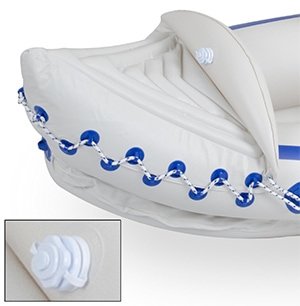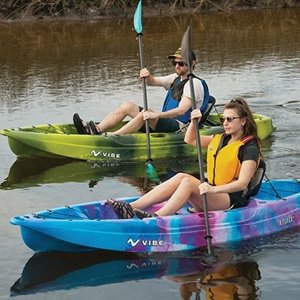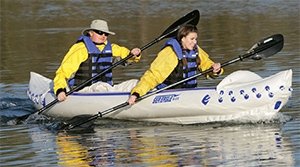With so many factors that go into buying a kayak it’s easy to see how it can be overwhelming. The very first consideration you’ll have is probably regarding inflatable vs rigid kayaks – and which is right for you.
You’ll need to know a little more about each type in order to make a choice. Should you opt for a hardshell kayak (commonly known as rigid kayaks) or an inflatable kayak?
The short answer is that it depends on a variety of factors, such as how you intend to use the kayak and what you need it to do for you. The type of water you’ll be paddling, the specific features of the kayak, and how comfortable you need the kayak to be are other factors to consider.
Let’s dive into the main differences between inflatable and hardshell kayaks. As we go over the key differences and how they can benefit you, you’ll be much closer to finding the right kayak for your needs. Let’s get started!
Key Takeaways
- You need to consider your needs and preferences before choosing between an inflatable kayak or a hardshell kayak.
- Inflatable kayaks are easy to transport and store, but they may not be as stable and fast as hardshell kayaks.
- Hardshell kayaks are more rigid, strong, and reliable, but they are also heavier, harder to repair, and require more space and equipment to move around.
- The type of activity you want to do on the water will also influence your decision. For example, fishing may be better with a hardshell kayak, while whitewater rafting may be more fun with an inflatable kayak.
- Both inflatable and hardshell kayaks have their pros and cons, and you should shop for a kayak that meets your requirements without the need for extra accessories or modifications.
What Are Kayaks Made Of?
As the world of kayaking evolves, the material used in kayak construction evolves with it. You’ll find that the best kayaking brands opt for highly durable materials in both their inflatable and hard shell kayak lineups.
So what are today’s leading kayaks made out of? Let’s take a look.
Inflatable Kayak Construction

As the name suggests, an inflatable kayak is made out of a flexible material that is divided into multiple chambers. These chambers then get inflated in order to create the boat that you will take out on the water. Inflatable kayaks have the advantage of being super easy to transport, unpack, and explore with.
For this reason, the materials used in an inflatable kayak have to be equally flexible yet strong enough to resist scratches and hopefully punctures while you’re out on the water.
You will find that the most commonly used material to create an inflatable kayak is a polyvinyl chloride (PVC) coated nylon or vinyl cloth. This PVC coated material gives an inflatable kayak a really durable construction that is incredibly resistant to harsh elements and scratches.
Different parts of the kayak may feature a different type of PVC coated material. For example, if the boat is designed to be used for specific activities that can cause high impact on the bow and the hull (such as whitewater rafting) then those parts of the kayak may be built with additional protection.
Depending on the activity your boat is used for, the type of material used to construct it will change. Boats made for recreational light touring may be made out of less durable materials than say a boat designed to double up a stand up paddle board.
Hardshell Kayak Construction

Unlike inflatables, hard shell kayaks are constructed – as their name suggests – using rigid material. Typically, a hard shell kayak Is made out of a solid material like plastic or fiberglass. Traditionally, wooden kayaks were the most common types of rigid kayaks there were.
A reinforced plastic is perhaps the most popular type of material used to build a hardshell kayak, especially recreational kayaks. Plastic kayaks are made out of a high density polyethylene material or HDPE. While they are really durable, they can be difficult to repair.
The chemical properties of HDPE do not bond well with other materials. So while you have the upside of a really flexible boat, the downside is if you puncture it, you might not be able to repair it.
Because plastic kayaks tend to be a bit on the heavier side, fiberglass was introduced as an alternative. Fiberglass kayaks are lightweight and easier to transport. The use of Kevlar has also become popularized as a common hard shell material to use too.
Which Costs More – An Inflatable Kayak or a Hardshell Boat?
There are several factors that determine the cost of a kayak. These can include the specific type of kayak, what it’s made out of, the brand, and of course any accessories that may come along with your kayak. All of these can directly affect the price you pay.
Typically speaking however, hardshell kayaks cost are usually higher than an inflatable kayak. This is because hard shell kayaks are built to last you a long time. The material, craftsmanship, and durability that a hard shell offers usually outweighs that offered by an inflatable.
How Does a Kayak’s Construction Drive the Price?

On the flip side however, inflatable kayaks have really stepped up their game over the past couple of years. Popular brands like Bote and Sea Eagle have revolutionized the way kayaks are constructed. Because of this, there are some great inflatable kayaks worth the money.
It used to be that inflatable boats offered two chambers that you inflated to a PSI of three or four. That simple construction has evolved to more advanced inflation designs including I-beam construction and drop stitch construction.
An I-beam inflation chamber offers more rigidity because the cavity that gets inflated features several beams that help the chamber keep a more rigid form. The same goes with the drop stitch construction.
Drop stitch technology features thousands of tiny fibers that connect the top of the inflation chamber to the bottom. Drop stitch offers more rigidity because you can inflate the chamber at a higher PSI, ranging anywhere from 6 to 10 PSI.
When you consider an inflatable made out of high quality insulation technology, this can boost the price point of the kayak immensely. The flip side of an inflatable like this is that you can take advantage of all the benefits of a hard shell kayak and not deal with the nuances associated with transporting a hard shell kayak.
Consider Additional Kayak Accessories
Another factor that can affect the price you pay for a kayak (both inflatable and rigid) is the accessories. If you need to accessorize your kayak to accommodate a certain sport like fishing or long distance touring, then this will impact how much you pay for your kayak.
One way to circumvent dishing out more money is by shopping for a kayak that meets your requirements, without the need for addons. For example, if you know you want a kayak for fishing purposes, then shop for inflatable or rigid kayaks designed specifically for fishing.
Consider Transportation and Storage

One of the biggest reasons people turn to inflatable kayaks is their ease of use. With a hard shell kayak you will need a set of roof racks or a kayak rack, a truck bed, or an additional flatbed to transport your kayak from one location to another. Not only that, but you also need to consider where you are going to store your hard shell once you’re done using it.
With inflatable yaks, all those factors become a non issue. Inflatable kayaks will pack neatly into a storage bag that should measure no more than 5 ft by 4 ft. Inflatable kayaks can be stored nicely in the trunk of your car or in the backseat of your car.
When it’s time to launch your kayak, you will also have greater flexibility. Some inflatable kayaks are packed in a backpack construction. This allows you to hike to remote or hard to reach locations in order to launch a kayak.
If you’re someone who likes to go on solo kayaking adventures, an inflatable kayak might be perfect for you. You won’t need to rely on someone else to help you pack, set up, or carry your kayak to its destination.
Hard shell kayaks on the other hand will require you to have some assistance. Even the most lightweight hard shell kayaks can be cumbersome to transport, launch, and then store afterwards.
Which Kayak Type Can Handle More Weight?
Knowing how much weight your kayak can hold is important for a comfortable and safe journey out on the water. The good news is when it comes to an inflatable kayak vs hardshell kayaks, this really isn’t an issue as both will typically hold the same amount of weight.
Both hard shell kayaks and inflatable kayaks can hold anywhere from 350 to 600 lbs. It mainly depends on the type of kayak you have, and what it’s built to withstand.
Also, both inflatable and hard shell tandem kayaks designed to hold two people will have a higher weight capacity ranging from 400 – 600 lbs.
Is a Hardshell Kayak Safer Than an Inflatable?
In the early years of inflatable kayaks, hard shell kayaks remained to be the safer option. Hard shell kayaks can handle rough bumps on the water, scratches, and strong waves. Hard shells are generally much more durable and won’t easily puncture.
Nowadays however, some inflatables can also do the same. Over the past couple of years, inflatable kayaks have been reinvented to handle class III and IV rapids. While the possibility of a puncture still exists, inflatables designed to handle rough waves can be just as safe an option.
If you are new to the kayaking world, you may not feel safe on an inflatable because of the bounce that is associated with crashing into waves or rocks. For this reason, a hard shell kayak may feel like a safer bet for an inexperienced kayaker.
Your experience level will also determine which type of kayak is the safest for you. For example, enclosed sit in hard shell kayaks may not be a good option for novice kayakers. These types of kayaks are known to flip in rough conditions. If your kayak flips and you get submerged underwater, you need to know how to flip back up properly to avoid drowning.
If your inflatable kayak does face a puncture while out on the water, you should still be relatively safe. High quality inflatable kayaks are made out of multiple air chambers. This is so that if one air chamber gets deflated the other air chambers can keep you afloat until you get back to shore.
ALSO READ: Do you have to register an inflatable kayak?
Consider the Versatility of Your Boat
One of the main things to consider when deciding between an inflatable kayak or a rigid kayak is what you’re going to use your kayak for. The type of activity you want to do out on the water will largely determine which type of kayak is best for you. Let’s take a look at some popular activities and whether or not an inflatable or a rigid kayak is best suited for it.
Inflatable vs. Hardshell — Which is best for Kayak Fishing?

While there are some amazing inflatable fishing kayaks designed for this sport specifically, you’ll typically find that rigid kayaks are the best option.
Hard shell kayaks that are made for fishing will have more rigidity giving you more stability as you fish. If you need to stand up, there won’t be as much of an issue balancing as you might have with an inflatable. Also, a hard shell kayak design for fishing will have specific compartments for you to put away your fishing gear.
Inflatable vs. Hardshell, Which is best for Whitewater Rafting
Inflatable kayaks designed to handle whitewater rapids are the best option to go with when it comes to white water rafting. When you do hit rough waves, an inflatable kayak will bounce off giving you a more enjoyable experience. Unlike a hard shell, the impact will not be as rough.
The important thing to keep in mind is that not all Inflatables are built alike. Some Inflatables are designed to handle class IV rapids, while others may only be able to handle class I or II.
It’s important that if you do opt for an inflatable, you make sure that you use it only on the rapids that it was designed for.
Inflatable vs. Hardshell, Which is best for Recreational Kayaking?
When it comes to recreational kayaking, both rigid and hardshell kayaks can serve you well. There are all sorts of inflatable kayaks that do an amazing job with recreational kayaking. Inflatable kayaks designed for light touring are easy to transport, put together, and launched.
Much of the same can be said for hardshell kayaks. Of course the downside of a hardshell is transporting it. There are a variety of hardshell kayaks designed specifically for recreational activities. To find the best one for you, consider your needs first.
If you want to focus on speed and good tracking then a narrow touring kayak might be good for you. If you want something a bit more comfortable, then an inflatable kayak may be the way to go.
READ NEXT: How Fast Is a Kayak? Average Kayak Speed Explained
Inflatable vs Rigid Kayak: Which is Better?
So, at the end of it all, which is better, an inflatable kayak or a hardshell one? The bottom line is it depends on you. Start by asking yourself what it is you are looking for in a kayak. If its ease of transportation, comfort, and versatility, then an inflatable might be a good fit.
If you are looking for something durable and strong to tackle rough waters then a hardshell might be the best way to go.
It can be tempting to focus on shopping for the kayak with the lower price tag or a model that has added bells and whistles, but that’s never the right route. Consider your needs first and what you want your kayak to do for you, then work your way through all the options. This will allow you to weed out all the wrong kayaks so that you can find the best fit for you.
YOU MAY ALSO LIKE: How durable are inflatable kayaks?
Conclusion
Knowing the details of inflatable kayaks vs their hard shell counterparts is the first step in finding your next kayak, whether it be your first kayak or your latest upgrade. We hope our detailed comparison of both has allowed you to have some clarity about which might be a good fit for you.
Which type of kayak do you think best suits your needs? Let us know in the comments section below!

